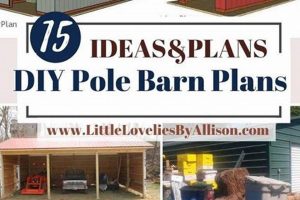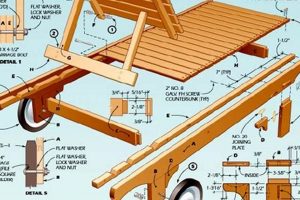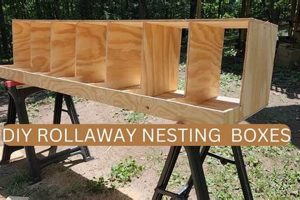Instructions detailing the construction of sleeping platforms by non-professionals are readily available. These guides typically include material lists, step-by-step assembly processes, and tool recommendations for individuals seeking to build their own bed foundations. Examples range from simple wooden platforms to more complex designs incorporating headboards, storage, or unique aesthetic elements.
Creating one’s own bed support structure offers several advantages. It facilitates customization to specific room dimensions or desired mattress heights, potentially leading to cost savings compared to purchasing pre-made frames. Historically, self-construction of furniture was common; this approach allows individuals to reconnect with that tradition and exercise their craftsmanship skills. Furthermore, it allows for the use of reclaimed or sustainably sourced materials, contributing to environmentally conscious practices.
The following sections will delve into various design considerations, material selection, and construction techniques relevant to the successful implementation of this type of project. Aspects such as structural integrity, aesthetic choices, and safety considerations will be addressed to provide a comprehensive overview.
Essential Guidance for Bed Foundation Self-Construction
The subsequent points highlight critical aspects to consider when undertaking the construction of a bed support structure. Adherence to these recommendations promotes structural soundness and user safety.
Tip 1: Material Selection is Paramount: Opt for hardwoods like oak or maple for superior strength and durability. Softwoods, such as pine, may require additional reinforcement to prevent sagging or breakage under load. Verify lumber is straight and free of knots or defects that could compromise structural integrity.
Tip 2: Prioritize Accurate Measurements: Precise measurements are crucial for ensuring a snug fit for the mattress and preventing instability. Account for the mattress’s dimensions, including any potential overhang or recess within the structure.
Tip 3: Secure and Robust Joinery is Essential: Utilize proven joinery techniques, such as mortise-and-tenon, dovetail, or reinforced screw connections. Insufficient joinery can lead to structural failure and potential injury.
Tip 4: Implement Adequate Support: For larger sizes, incorporate a center support beam to prevent mattress sagging. The beam should be adequately sized and braced to distribute weight evenly across the structure.
Tip 5: Consider Ventilation: Design the frame with sufficient airflow beneath the mattress to prevent moisture buildup and potential mold growth. Slatted platforms or raised designs promote ventilation.
Tip 6: Ensure Smooth Surfaces and Edges: Thoroughly sand all surfaces and round over sharp edges to prevent snagging bedding or causing injury. A smooth finish also enhances the overall aesthetic appeal.
Tip 7: Apply a Protective Finish: Apply a durable finish, such as varnish or sealant, to protect the wood from moisture, scratches, and wear. Choose a non-toxic finish to ensure user safety.
By meticulously following these guidelines, a stable, aesthetically pleasing, and durable bed foundation can be achieved. Attention to detail during the construction process will result in a lasting piece of furniture.
The following section will address common challenges encountered during the construction phase and propose effective solutions for overcoming these obstacles.
1. Material Selection
The choice of materials is a foundational element in the success or failure of any bed support structure. The selected materials directly influence the frame’s durability, stability, aesthetic appeal, and overall cost. Careful consideration is, therefore, paramount before initiating construction.
- Wood Species and Structural Integrity
Different wood species possess varying degrees of strength, density, and resistance to decay. Hardwoods, such as oak, maple, and walnut, offer superior structural performance compared to softwoods like pine or fir. While softwoods are often more economical, their lower density requires careful design and potentially increased material volume to achieve comparable load-bearing capacity. The choice of wood species directly impacts the frame’s ability to withstand prolonged use and resist deformation over time.
- Hardware and Fastener Durability
The quality of screws, bolts, brackets, and other fasteners is often overlooked but equally crucial. Inferior hardware can strip, shear, or corrode, compromising the integrity of joints and leading to structural weakness. Selecting high-quality fasteners made from hardened steel or corrosion-resistant alloys ensures reliable connections and prevents premature failure. Consider the load-bearing capacity of each fastener and choose accordingly.
- Finish and Protective Coatings
The application of a suitable finish protects the wood from moisture, scratches, and stains, thereby extending the lifespan of the structure. Options range from traditional varnishes and lacquers to modern polyurethanes and water-based coatings. The choice of finish should be based on the desired aesthetic, level of durability, and environmental considerations. Some finishes may release volatile organic compounds (VOCs), making water-based options preferable for indoor use. Improper application of finish can lead to bubbling, peeling, or uneven coverage.
- Material Source and Sustainability
The origin of the materials used contributes to the environmental impact of the project. Opting for locally sourced lumber reduces transportation costs and supports local economies. Furthermore, utilizing reclaimed wood or sustainably harvested timber minimizes deforestation and promotes responsible forest management practices. Consider the certification of lumber (e.g., Forest Stewardship Council) to ensure it meets environmental standards. The choice of material source reflects a commitment to sustainability and responsible consumption.
The integration of material selection best practices directly determines the longevity and performance of the self-constructed bed frame. A structured design and skilled workmanship are rendered ineffective if the foundational materials are substandard or ill-suited for the intended purpose. Thus, prioritizing material quality and responsible sourcing is paramount for successful implementation.
2. Structural Integrity
Structural integrity is a non-negotiable requirement in the realm of self-constructed bed frames. A bed frame lacking sufficient structural resilience poses significant safety risks to the user. It also impacts the frame’s ability to provide adequate support for the mattress, potentially reducing its lifespan and compromising sleep quality. Therefore, designs for these projects must prioritize and rigorously address the factors contributing to long-term stability and load-bearing capacity.
- Joint Strength and Connection Methods
The method of joining frame components directly impacts overall structural integrity. Weak joints are prone to failure under stress, leading to instability or collapse. Employing proven joinery techniques, such as mortise-and-tenon, dovetail, or reinforced screw connections with appropriate adhesives, is crucial. Joint design must account for anticipated loads and stress points. Insufficient joint strength will compromise the entire structure, regardless of material quality. Common examples of failures include wobbly legs, separated headboards, or complete collapse under weight.
- Load Distribution and Support Systems
A properly designed frame distributes weight evenly across all support points, preventing localized stress concentrations that can lead to failure. Center support beams are essential for larger sized frames (e.g., queen, king) to mitigate mattress sagging and prevent structural deformation over time. The support system should extend across the entire frame, providing consistent and reliable support for the mattress and occupants. Poor load distribution often manifests as bowing side rails, cracking joints, or uneven mattress support, reducing comfort and shortening the frame’s lifespan.
- Material Properties and Dimensions
The inherent strength and stiffness of the chosen material, combined with its dimensions (e.g., thickness, width), directly influence the frame’s ability to withstand applied loads. Utilizing undersized or structurally inadequate materials will inevitably lead to failure. Hardwoods, such as oak or maple, offer superior strength compared to softwoods like pine. Material dimensions must be sufficient to handle the anticipated weight and stress. An example would be a frame constructed from thin pine boards which is likely to sag or break under the weight of a mattress and occupants.
- Frame Geometry and Bracing
The overall geometry of the frame, including the angles and arrangement of components, significantly impacts its structural stability. Incorporating bracing elements, such as corner braces or diagonal supports, enhances rigidity and prevents racking or twisting. A well-designed frame utilizes triangulation and other structural principles to maximize strength and minimize deflection under load. Lack of proper bracing results in frames that are prone to wobbling, squeaking, or even collapsing under lateral forces.
In conclusion, a successful self-constructed bed frame necessitates a comprehensive understanding of structural principles and their application in design and construction. Failure to adequately address these factors will inevitably result in a compromised structure that is unsafe, unreliable, and ultimately unsustainable. Prioritizing structural integrity through proper material selection, robust joinery, and effective load distribution is paramount to ensuring a durable and safe sleeping platform.
3. Accurate Measurements
The precision of dimensions constitutes a foundational element in the successful execution of any bed frame self-construction project. Deviations from specified measurements, however minor, can propagate through the assembly process, resulting in structural instability, aesthetic incongruities, and functional deficiencies. The integration of precise measurement practices is therefore paramount.
- Mattress Compatibility and Fit
Dimensional accuracy directly dictates the compatibility between the completed frame and the intended mattress. Undersized frames render mattress placement impossible, while oversized frames introduce unwanted gaps, potentially leading to shifting and reduced support. Standard mattress sizes necessitate strict adherence to specified dimensions. Inaccurate measurements in this context may result in the need for costly modifications or complete project abandonment.
- Component Alignment and Structural Integrity
Precise measurements are crucial for ensuring accurate alignment of individual frame components. Misalignment introduces stress points and weakens joints, thereby compromising overall structural integrity. Consistent and accurate measurements guarantee that all parts fit together as intended, distributing weight evenly and preventing localized stress concentrations. Deviation from precise dimensions may lead to instability and premature failure under load.
- Symmetry and Aesthetic Consistency
Dimensional accuracy is essential for achieving visual symmetry and aesthetic consistency in the finished bed frame. Inconsistencies in component lengths or angles disrupt visual harmony and detract from the overall appearance. Accurate measurements ensure that all sides and angles are uniform, contributing to a balanced and visually appealing design. Asymmetrical elements stemming from measurement errors can diminish the professional appearance of the final product.
- Material Optimization and Cost Efficiency
Precise measurements enable efficient material utilization, minimizing waste and reducing project costs. Accurate material calculations, based on precise dimensions, prevent over-ordering and subsequent disposal of surplus materials. Conversely, underestimation due to inaccurate measurements can necessitate additional material purchases, adding to the overall expense and potentially delaying project completion. Effective implementation of accurate measurement practices optimizes resource allocation and promotes cost-effective construction.
The aforementioned facets highlight the indispensable role of dimensional accuracy in bed frame self-construction projects. Failure to prioritize precision in measurement practices can lead to functional impairments, structural weaknesses, aesthetic deficiencies, and economic inefficiencies. Successful project execution, therefore, necessitates a commitment to meticulous measurement and adherence to specified dimensions throughout the design and construction phases.
4. Aesthetic Considerations
The integration of aesthetic preferences into bed frame self-construction is not merely superficial; it represents a fundamental aspect of personalizing living spaces and enhancing the user experience. The visual characteristics of a bed frame, including its style, color, and detailing, exert a significant influence on the overall ambiance of a bedroom. The aesthetic choices directly impact the perceived comfort, relaxation, and visual appeal of the environment. Therefore, while structural integrity and functionality remain paramount, the consideration of aesthetic elements plays a crucial role in creating a harmonious and satisfying sleeping space.
The interplay between personal taste and construction skills is evident in numerous examples. A minimalist aesthetic might dictate a simple, platform-style frame constructed from light-colored wood with clean lines and minimal ornamentation. Conversely, a rustic aesthetic might favor a frame built from reclaimed wood, incorporating visible knots and imperfections to evoke a sense of history and authenticity. Individuals seeking a more opulent design could integrate upholstered headboards, intricate carvings, or metal accents. The selection of materials, finishes, and decorative elements directly reflects the desired aesthetic and demonstrates the tangible link between design intention and constructive execution. Furthermore, the success of the aesthetic hinges on skillful craftsmanship; poorly executed details can undermine even the most well-conceived design.
Ultimately, the integration of aesthetic considerations into the construction of a bed frame extends beyond mere visual appeal. It facilitates the creation of a personalized sanctuary, fostering a sense of comfort and well-being. While challenges may arise in translating abstract aesthetic visions into tangible structures, the ability to harmonize design preferences with construction skills enables individuals to craft bed frames that are not only structurally sound but also aesthetically enriching. The blending of form and function results in furniture that elevates the entire living space.
5. Joinery Techniques
The execution of a structural framework, specifically in the context of self-constructed bed foundations, relies heavily on the application of appropriate joinery techniques. The integrity of these joints dictates the overall stability, load-bearing capacity, and longevity. Inadequate or improperly executed joinery directly compromises the entire structure, regardless of material quality. For example, a bed frame constructed with butt joints secured only by screws will exhibit significantly less strength and stability than one employing mortise-and-tenon or dovetail joints. The selection and implementation of these methods represent a critical determinant of structural success.
Various joinery methods offer different levels of strength and complexity. Mortise-and-tenon joints, characterized by a projecting tenon fitted into a corresponding mortise, provide substantial resistance to racking and shear forces. Dovetail joints, with their interlocking, wedge-shaped projections, offer exceptional tensile strength and prevent joint separation. Simpler techniques, such as pocket-hole joinery or the use of metal fasteners, may be suitable for less critical connections or when ease of assembly is prioritized. However, these methods often necessitate supplemental reinforcement to achieve comparable structural performance. Consider the type of wood used; softer wood needs different joinery than hardwood.
The mastery and proper application of joinery techniques are essential for constructing a safe and durable bed frame. Understanding the strengths and limitations of different methods, along with careful execution, minimizes the risk of structural failure and ensures a stable sleeping platform. In summary, adequate consideration of the types of joinery for “diy bed frame plans” are fundamental to a lasting product.
Frequently Asked Questions
The following questions address common inquiries and concerns regarding the construction of sleeping platform structures. The information provided aims to clarify prevalent misconceptions and offer guidance based on established construction principles.
Question 1: What are the primary safety considerations during construction?
Ensuring personal safety during the construction process is paramount. Eye protection is critical when cutting or sanding materials. Adequate ventilation is required when applying finishes that may release harmful fumes. Power tools must be operated according to manufacturer instructions, and adherence to recommended safety precautions is mandatory to prevent injury.
Question 2: What is the recommended type of wood for optimal structural integrity?
Hardwoods, such as oak, maple, or walnut, are generally preferred for their superior strength and resistance to deformation. Softwoods, like pine or fir, may be suitable for less critical components or when cost is a primary concern, but may necessitate increased dimensions or additional reinforcement to achieve comparable load-bearing capacity.
Question 3: How can mattress slippage be prevented?
Mattress slippage can be mitigated through several methods. Recessing the mattress slightly within the frame creates a physical barrier. Applying a non-slip material, such as rubber strips, to the frame’s surface can increase friction. Using a fitted sheet with adequate elastic tension also aids in preventing movement. Avoid excessive frame dimensions relative to the mattress size.
Question 4: What type of finish is best for indoor air quality?
Water-based finishes are generally considered to be more environmentally friendly and release fewer volatile organic compounds (VOCs) compared to solvent-based alternatives. Opting for finishes certified as low-VOC contributes to improved indoor air quality. Proper ventilation during application and drying is crucial, regardless of the type of finish used.
Question 5: Is specialized equipment necessary?
While specialized equipment can expedite the construction process, it is not strictly necessary. A basic set of tools, including a saw, drill, measuring tape, level, and screwdriver, is sufficient for most designs. However, access to power tools, such as a power saw or sander, can improve efficiency and precision. The complexity of the planned construction will determine equipment needs.
Question 6: How does one ensure proper support for larger mattress sizes?
Larger mattress sizes (e.g., queen, king) require additional support to prevent sagging and ensure even weight distribution. Incorporating a center support beam, adequately sized and braced, is essential. The beam should run lengthwise along the frame’s center and be supported by legs or posts. Adequate cross-supports are also necessary to distribute weight evenly across the frame.
Adherence to these recommendations promotes safe and successful construction. Understanding the material properties, appropriate joinery techniques, and potential safety hazards involved is crucial for a stable and long-lasting structure.
The following section provides resources and references for further study and investigation into construction methods.
Conclusion
This article has explored the multifaceted aspects of self-constructing a bed foundation. Essential elements such as material selection, structural integrity, accurate measurements, aesthetic considerations, and joinery techniques have been addressed. Furthermore, common questions regarding safety, wood selection, and equipment have been answered to promote a comprehensive understanding.
The information contained herein serves as a foundation for individuals contemplating this undertaking. Diligent planning, adherence to safety protocols, and a commitment to quality craftsmanship are paramount for successful implementation. Further research and consultation with experienced builders are encouraged before commencing construction to ensure a durable and safe outcome.







